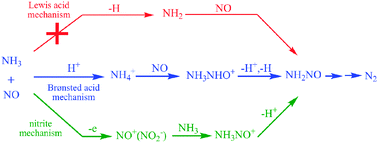Brønsted-NH4+ mechanism versusnitrite mechanism: new insight into the selective catalyticreduction of NO by NH3†
Abstract
The selective

* Corresponding authors
a
State Key Laboratory for Physical Chemistry of Solid Surfaces, College of Chemistry & Chemical Engineering, Department of Chemistry, Xiamen University, Xiamen, China
E-mail:
xinxu@xmu.edu.cn, hlwan@xmu.edu.cn
The selective

 Please wait while we load your content...
Something went wrong. Try again?
Please wait while we load your content...
Something went wrong. Try again?
R. Yuan, G. Fu, X. Xu and H. Wan, Phys. Chem. Chem. Phys., 2011, 13, 453 DOI: 10.1039/C0CP00256A
To request permission to reproduce material from this article, please go to the Copyright Clearance Center request page.
If you are an author contributing to an RSC publication, you do not need to request permission provided correct acknowledgement is given.
If you are the author of this article, you do not need to request permission to reproduce figures and diagrams provided correct acknowledgement is given. If you want to reproduce the whole article in a third-party publication (excluding your thesis/dissertation for which permission is not required) please go to the Copyright Clearance Center request page.
Read more about how to correctly acknowledge RSC content.
 Fetching data from CrossRef.
Fetching data from CrossRef.
This may take some time to load.
Loading related content
